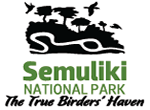The 220 square km Semuliki National Park lies in the isolated Bundibugyo district, beyond the Rwenzori mountain on the floor of the Semliki section of the Albertine Rift Valley. This largely forested park represents the easternmost limit of the great Ituri Forest of the Congo Basin and contains numerous species associated with central rather than eastern Africa. Thatch huts are shaded by West African oil palms, the Semliki River (which forms the international boundary) is a miniature version of the Congo River, while the local population includes a Batwa (Pygmy) community that originated from the Ituri. As a result, a visit to Semuliki provides a taste of Central Africa just a couple of hours from the comforts of Fort Portal.
Semuliki is one of Africa’s most biodiverse forests and is particularly noted for its varied bird population. This biodiversity is enhanced by its great age, for it is one of Africa’s most ancient forests. During the dry conditions of the last ice age, 12-18,000 years ago, most of Africa’s forests shrank and disappeared. Only a few patches like Semuliki and Bwindi survived, protecting forest species during the arid apocalypse until they could eventually emerge to recolonise a better, wetter world. Today the Semuliki valley is a hothouse for vegetation growth, with temperatures rising to a humid 30°C doused by an annual 1250mm of rain, mostly between March-May and September-December.
While Semuliki’s species have been evolving for over 25,000 years, the park contains evidence of even older processes.
Hot springs bubble up from the depths beneath Sempaya to demonstrate the powerful subterranean forces that have been shaping the rift valley during the last 14 million years. The low lying park lies on the rift’s sinking floor, most of it just 670m above sea level. Large areas may flood during the wet seasons; brief reminders of the time when the entire valley lay at the bottom of a lake for 7 million years.
The Semuliki Forest Reserve was created in 1932 when forest villages were evacuated as a measure to control sleeping sickness and yellow fever. The reserve was upgraded to national park status in 1993.
